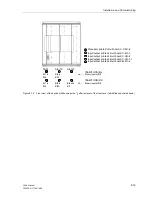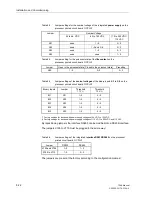
Installation and Commissioning
8-14
7SA6 Manual
C53000-G1176-C156-2
Pilot Wire
Protection
If the transmission scheme
Teleprot. Dist.
=
Pilot wire comp
(address
121
)
is applied in the Distance Protection, the user has to make sure that the closed current
loop is supplied with enough auxiliary voltage. The function itself is described in Sub-
section 6.4.1.8.
Please take note that both binary inputs are interconnected and connected in series
with the resistor of the pilot wires. Therefore the loop voltage must not be too low or
the pickup voltage of the binary inputs must not be too high. In general, the lowest
threshold (19 V) must be selected for the auxiliary voltages of 60 V to 125 V, the
threshold of 73 V is selected for voltages of 220 V to 250 V.
Due to the low current consumption of the binary inputs it may be necessary to addi-
tionally burden the pilot wire loop with an external shunt connected resistor so that the
input to the binary inputs are not maintained by the charge on the pilot wire capaci-
tance after interruption of the loop.
Pilot wires used as cable connections between stations must always be checked on
their effect on high voltage. The pilot wires of the pilot cables must stand external
strains.
The worst electrical fault that may occur to the connected pilot cables is generated in
the pilot wire system by an earth fault. The short-circuit current induces a longitudinal
voltage into the pilot wires lying parallel to the high voltage line. The induced voltage
can be reduced by well-conductive cable jackets and by armouring (low reduction fac-
tor, for both high voltage cable and pilot cables).
The induced voltage can be calculated with the following formula:
U
i
= 2
π
f · M ·
I
F1
· l · r
1
· r
2
with
U
i
= induced longitudinal voltage in V,
f
= nominal frequency in Hz,
M
= mutual inductance between power line and pilot wires in mH/km,
I
F1
= maximum earth fault current via power line in kA,
l
= length; distance between energy line and pilot wires in km,
r
1
= reduction factor of power cable (r
1
= 1 for overhead lines),
r
2
= reduction factor of pilot wire cable.
The calculated induced voltage should neither exceed the 60 % rate of the test voltage
of the pilot wires nor of the device connections (binary inputs and outputs). Since the
latter were produced for a test voltage of 2 kV, only a maximum induced longitudinal
voltage of 1.2 kV is allowed.
Summary of Contents for siprotec 7SA6
Page 2: ...Siemens Aktiengesellschaft Book No C53000 G1176 C156 2 ...
Page 18: ...xviii 7SA6 Manual C53000 G1176 C156 2 ...
Page 32: ...Introduction 1 14 7SA6 Manual C53000 G1176 C156 2 ...
Page 82: ...Hardware and Connections 2 50 7SA6 Manual C53000 G1176 C156 2 ...
Page 119: ...SIPROTEC 4 Devices 4 25 7SA6 Manual C53000 G1176 C156 2 Figure 4 20 CFC Logic example ...
Page 190: ...Configuration 5 62 7SA6 Manual C53000 G1176 C156 2 ...
Page 652: ...Installation and Commissioning 8 78 7SA6 Manual C53000 G1176 C156 2 ...
Page 724: ...Technical Data 10 56 7SA6 Manual C53000 G1176 C156 ...
Page 800: ...Appendix A 76 7SA6 Manual C53000 G1176 C156 2 ...
Page 866: ...Appendix B 66 7SA6 Manual C53000 G1176 C156 2 ...
















































